9 Practical & Sustainable Toilet Paper Alternatives
Last Updated on September 13, 2023 by toilethaven
Toilet paper was probably unheard of until around 1857 when Joseph Gayetty commercialized it. So, what were people using before toilet paper was invented?
According to Toilet Paper History, people used leaves, grass, corn cobs, snow, fruit skins, seashells, ferns, stones, or water to clean their behinds. Wealthy folks in the Roman empire used wool or a sponge attached to a wooden stick and then soaked it in salty water.
Since the invention of toilet paper, a trip to the bathroom has become more comfortable. It must have been tough wiping your bum with a corn cob or a rock.
The only disadvantage to using toilet paper is that its production hurts the environment. In the US alone, 15 million trees are felled yearly to manufacture toilet paper.
Toilet paper products also consume a lot of energy and water. Chemicals such as bleach, used to whiten toilet paper, also negatively affect the ecosystem.
What can we say is the best alternative to toilet paper? Can human beings live without toilet paper?
The best and the most sanitary alternative to toilet paper is bidets. It could be stand-alone bidets, bidet seats, attachments, or even hand-held bidets. Although reusable cloths are often recommended as an alternative to toilet paper, they are neither practical nor hygienic.
What are Bidets?
Bidets are bathroom fixtures that use water to clean the toilet user. They have been used since the 17th century when they were invented in France.
There are 6 types of bidets to choose from. These are
- Stand-alone bidets
- Bidet toilet seats
- Bidet attachments
- Hand-held bidet sprayers
- Bidet toilet combos
- Portable/bottle bidets
You can replace toilet paper using any of the above bidets. Depending on your situation, you will find that one type of bidet will be more suitable than others.
The 9 Best Toilet Paper Alternatives
The following are the 9 best alternatives to toilet paper. You will notice that I am biased towards the use of bidets.
I genuinely think that water (bidets) is the most sustainable alternative to toilet paper if we want to save our environment. Bidets are not necessarily cheaper, but they are a perfect choice for the modern times that we are living in.
1. Stand-Alone Bidets
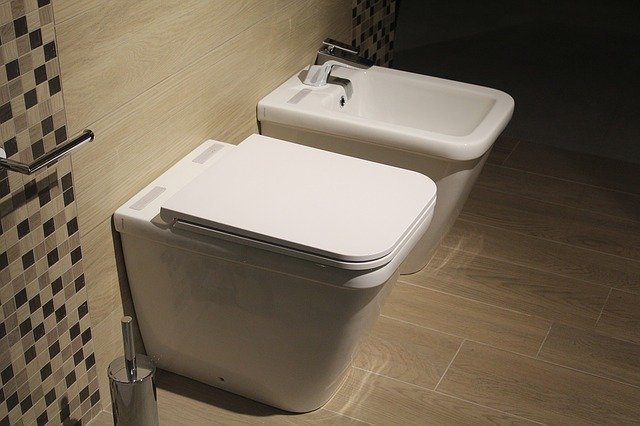
Stand-alone bidets are oval-shaped/square porcelain fixtures installed next to the toilet, either on the floor or on the wall. They look almost like toilet bowls but do not have a seat and a large outlet at the bottom but have control knob(s) at the back.
Although stand-alone bidets have been in use for a long time in many countries, especially in Europe and Asia, they are not very common in North America. There are two main reasons to explain why that is the case:
- They were associated with prostitution and family planning procedures. This is something that didn’t sit well with conservative America at the time. World War II soldiers returning to the US from Europe confirmed the allegations as accurate, which killed any hopes of stand-alone bidets making it big in North America.
- Stand-alone bidets need to be installed on the floor or wall of the bathroom, meaning you need extra space in your bathroom. Most Americans did not see the need to install additional bathroom plumbing when they could just use old good toilet paper.
To effectively use a stand-alone bidet, you will need to remove your pants and straddle them to directly face the water temperature and pressure control knobs. You will also be able to clean your rear and front properly.
You may sit on the bidet or squat. Just make sure that water does not splash all over the bathroom. You are opening the knobs slowly as you will be unsure of the water pressure.
If you don’t want to completely remove your pants, it is still OK, but you can’t straddle the bidet, meaning you can’t easily control the temperature and pressure of the water.
There are two ways to dry yourself after using a stand-alone bidet. You can use a towel or toilet paper. If the bidet is in your home, you can dedicate one towel for that purpose. If you are visiting someone else’s house, you should dry yourself with toilet paper. Use the towel to dry your hands.
Stand-alone bidets do not entirely eliminate the use of toilet paper since people still have to use them to dry themselves.
2. Bidet Toilet Seats

Bidet toilet seats are seats with a retractable nozzle at the back. They are also connected to the toilet water supply line to offer posterior and front cleansing after using a toilet. A bidet toilet seat can either be electric or non-electric.
Electric bidet seats are the best option to completely eliminate your reliance on toilet paper. They offer the following functions:
- Warm water cleansing
- Adjustable nozzle positions
- Warm air drying
- Heated seat
- Nightlight
- Deodorizing
Bidet toilet seats are installed on top of the toilet bowl, just like ordinary toilet seats. A T-valve is installed on the water supply line so that water will flow to the toilet tank and the bidet seat.
The best bidet seats will cleanse you using warm water, whose temperature and pressure can be adjusted. This water is infused with air bubbles (aeration) to provide a gentle but thorough wash.
The position of the nozzle can be adjusted either forward or backward to accommodate people of all sizes. Choosing an oscillating cleanse option on the remote will have the nozzle moving back and forth rapidly to clean over a wide area.
A pulsating wash option prompts the nozzles to release alternating strong and soft warm water streams, which have a massage sensation. You can run both pulsating and oscillating clean options concurrently.
As soon as you are properly cleaned, the nozzle retracts to the back of the seat, and a warm air dryer starts blowing hot air all over your behind. The temperature of the air dryer can be adjusted to your preferred settings.
For people who suffer frequent constipation, the Bio Bidet BB 2000 bidet seat would be of interest to them. It is the only one that offers an enema wash. An enema wash involves using a thin but strong water stream that is very effective in alleviating constipation.
Non-electric bidet seats do not offer most of these functions. The water from the nozzle is cold, and a dryer is not available. You will, therefore, still need to use a towel or toilet paper to dry yourself after cleaning.
If you would like to read more on 7 of the best bidet toilet seats in the market, check out this post I wrote a while ago.
3. Bidet attachments
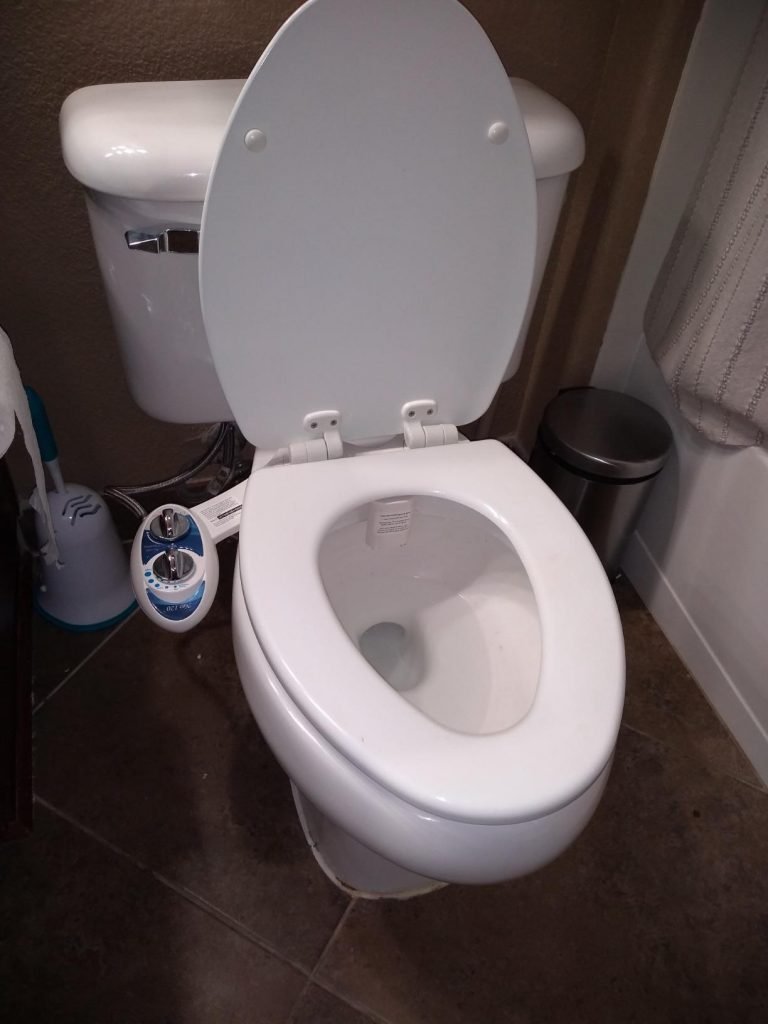
A bidet attachment is an inexpensive bidet installed between your existing toilet seat and the bowl. Bidet attachments are non-electric.
They contain a thin bracket with a nozzle and a knob on the side. Some have more than one knob. The knob(s) is used to start the water flow and also adjust the water pressure.
Bidet attachments do not have as many functions as those in electric bidet seats. They clean you using cold water and do not have a warm air dryer. To dry yourself after cleaning with a bidet attachment, you would need to use a towel or toilet paper.
Some bidet attachments, like the Luxe Bidet Neo 320, will, however, give you the option to choose either cold or hot water. They come with an extra hose that connects to your bathroom sink’s hot water line.
The main advantage of bidet attachments over other types is their affordability. I wrote a detailed guide on the best bidet attachments in the market a while ago. Please read it here.
4. Bidet Toilet Combo
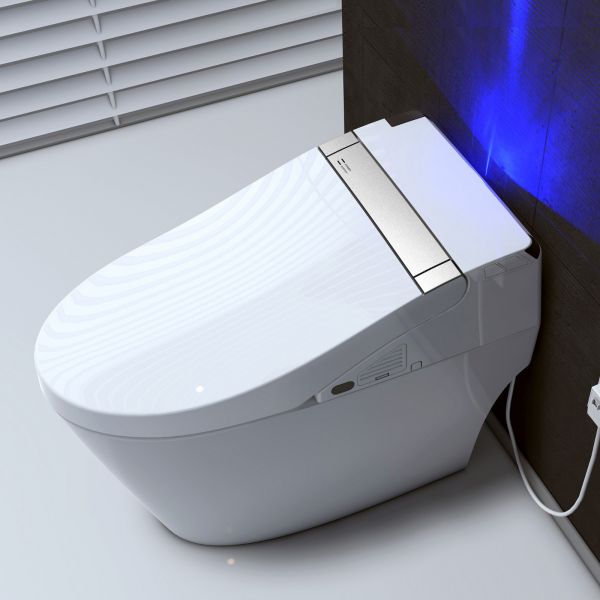
A bidet toilet combo is a combination of a bidet seat and a toilet made and sold as one unit. They are primarily found in tankless and smart toilets.
If you are looking for total luxury, these are the bidets to buy. High-end bidet toilet combos provide the following and more functions:
- Auto lid opening and closing
- Automatic flushing
- Adjustable warm water cleaning
- Adjustable warm air-drying
- Deodorizing
- Heated seat
- Nightlight
If you would like to read more on this topic, check out this post, where I reviewed 7 of the best bidet toilet combos.
5. Hand-held Bidet Sprayers
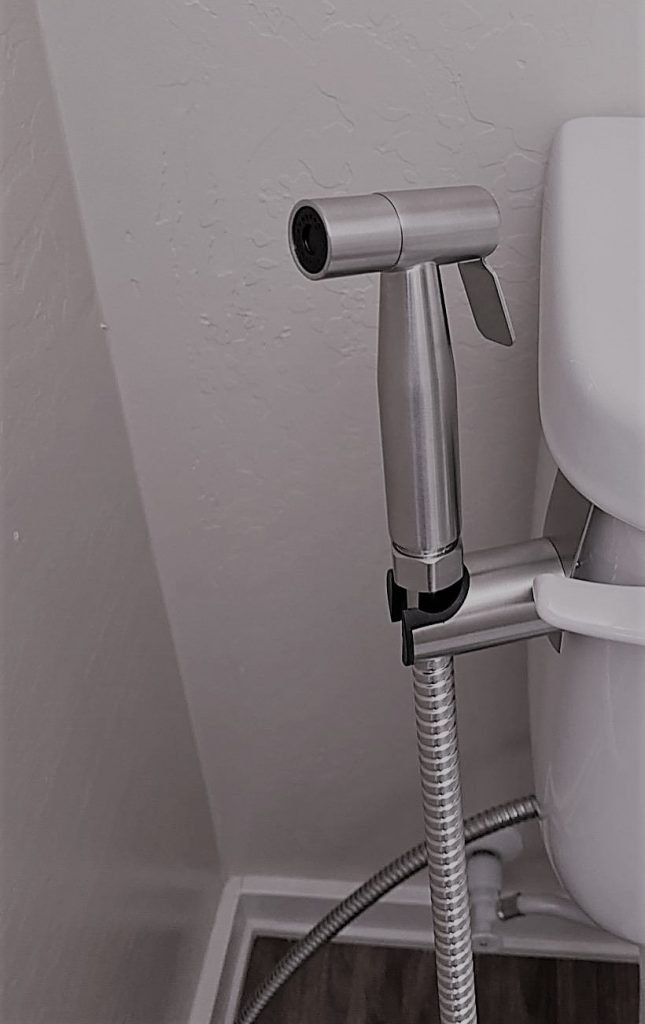
A hand-held bidet sprayer looks like a shower head but is small in size. It comes with a bidet hose and a T-valve.
Just like in other types of bidets, the T-valve creates a junction where water flows to both the tank and the shower head. It is normally mounted on the wall or on the tank when not in use.
To clean yourself with a bidet sprayer, you can opt to pass it through the front or the back of the toilet bowl. Hold the bidet head at an elevated angle so the water and waste will fall downwards into the bowl and not against your body.
There is a trigger at the top of the bidet that you pull down to initiate the cleaning process. Start by pulling slowly since the water pressure might be higher than expected.
Unfortunately, bidet sprayers do not have a way of drying the toilet user after cleaning. You would, therefore, need to dry yourself with a towel or toilet paper.
They are, however, generally inexpensive and, therefore, a great alternative to toilet paper for those who cannot afford high-end bidets.
6. Portable Bidets
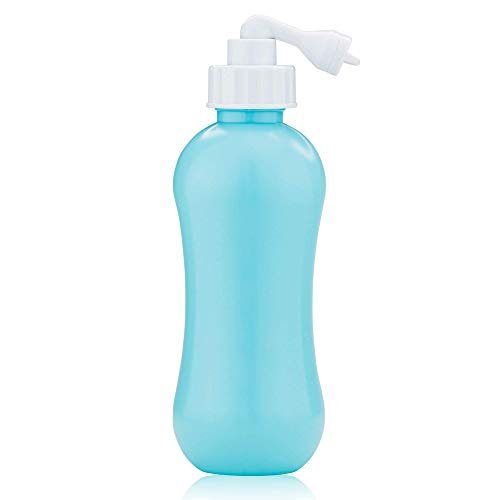
Portable bidets, or bidet bottles, are simple plastic bottles with a nozzle that screws at the top of the bottle. They are a great toilet paper alternative while camping.
If you have used a portable camping toilet or an RV toilet, you know how easily toilet paper can cause clogs. By eliminating toilet paper and embracing a bidet bottle, toilet clogs will almost be a thing of the past.
7. Reusable Toilet Paper
Reusable toilet paper is not made of paper but rather a cloth as a substitute for toilet paper.
You can either make yours at home or you can opt to buy an already made one. This is not an option many people would consider since it involves touching human waste, but it works.
If you decide to make yours at home, make sure that you use a soft material, preferably cotton. You can choose to use the cloth while dry or wet it with a little water before use. Warm water would be ideal.
If you are making reusable toilet cloths for an entire household, consider choosing materials of different colors. That way, each family member can easily identify their clothes. Square clothes measuring 4 X 4 inches are recommended.
Proper hygiene should be observed while using cloths as an alternative to toilet paper. They should be regularly cleaned and disinfected. Use baking soda and vinegar to remove any unpleasant odors.
The main disadvantage of reusable clothes is that you can only have so many in the bathroom. Try to imagine an instance when you have guests over, and each time they want to use the bathroom, you hand them a cloth. It is not ideal.
This is why I think bidets are the most practical alternatives to toilet paper. Reusable toilet cloths would be extremely helpful during “emergencies.”
8. Old Papers
Every house has some old papers, be it newspapers, receipts, novels, etc. These can be a quick and great alternative if you have no toilet paper in the house.
Most of these papers should not be used as they are, as they are made so smooth and would only serve to smear poop instead of wiping it. You should, therefore, look for a way to soften them and look as much as possible like toilet paper.
One great way of doing that is holding the paper with both hands and rubbing it against itself. I learned this trick from a friend while stuck in a public bathroom without toilet paper.
I would, however, not recommend printed paper as an everyday alternative to toilet paper. This is because the ink used on the paper contains dyes, some of which might react badly with your skin. Have you never wondered why they stopped making colored toilet paper?
9. Leaves
One of the best toilet paper alternatives while camping is plant leaves. Look for a plant with broad and thick leaves and pluck several. It would be best if you were sure of the plant to ensure it doesn’t sting.
Leaves do not break down easily and should, therefore, never be flushed. This is especially the case if you are using a flushable portable toilet.
To prevent leaving waste lying on the ground, dig a shallow hole in the ground and bury the leaves. Leaving human waste lying on the ground is irritating and could cause waterborne diseases.
If you are camping with a bucket toilet, you can throw the leaves inside the bucket and dispose of them as you dispose of the waste.
Advantages of Using Water Instead of Toilet Paper
While comparing toilet paper and water, I like to give the analogy of a dirty car. Would you clean a dirty car with water or simply wipe it with a rag?
Without getting too graphic, most of the time, toilet paper smears waste around your behind as opposed to water, which removes everything. The following are the main advantages of using water (bidets) instead of toilet paper.
- Improved hygiene. Unlike when using toilet paper, where there is an increased chance of touching the waste, bidets eliminate the need to use your hand against your body. According to the Center for Disease Control, feces are a great host for germs, which causes diarrhea and other diseases. Using water to clean yourself effectively will help prevent such and more diseases.
- It is Eco-friendly. Using water instead of toilet paper will avoid the cutting down of trees to make toilet paper. It will also eliminate the need to use bleach, which most likely ends in our water resources.
- It saves water. Believe it or not, making one toilet paper roll requires 37 gallons of water.
- Gentle on the skin. Water is gentler on the skin than the softest toilet paper. It is especially a great option for people who suffer from hemorrhoids.
Is Bamboo Toilet Paper Better?
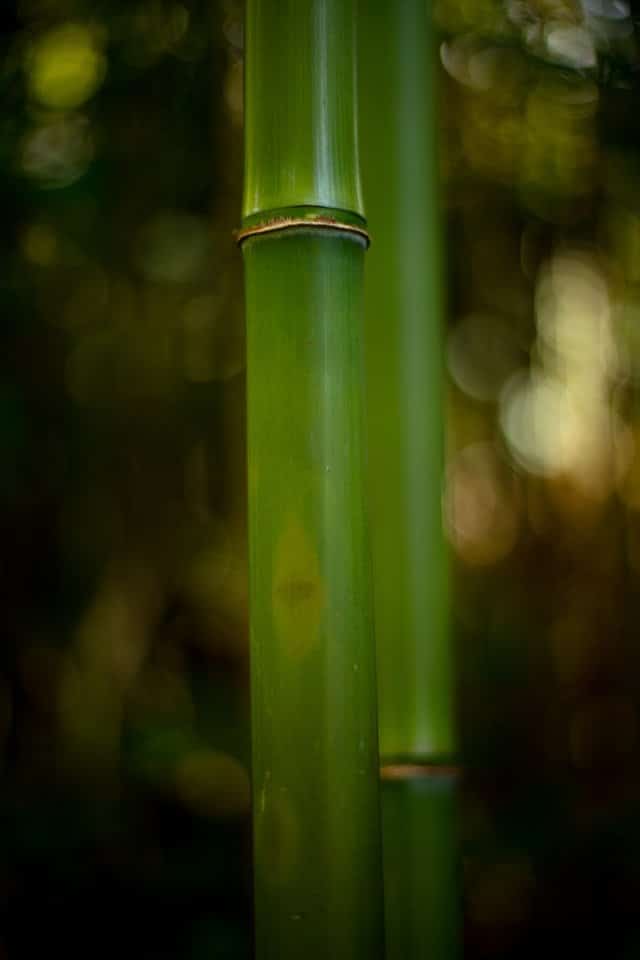
It is said that bamboos take so long to germinate, but as soon as they do, they start growing at an astonishing rate. Some people say that you can even see them grow. The Chinese bamboo is said to grow at a rate of 3 feet a day!
If the above information is true, compare that to how long it takes other trees to grow. Decades. The best thing is that bamboo starts regrowing as soon as they are cut, meaning bamboo can be harvested continuously, which is not the case with other trees.
Harvesting bamboo trees to make toilet paper makes more sense than cutting down trees that would take decades to grow again. Bamboo toilet paper is, therefore, very Eco-friendly and should be considered by everyone who cares about our environment.
Another thing I love about bamboo toilet paper is that it is 100% biodegradable. It breaks down easily and will not clog up your drains. If you are on a septic system, then bamboo toilet paper is something you should consider.
FAQs
1. What is the best backpacking toilet paper alternative?
From experience, the best toilet paper alternative while backing is a portable bidet, also known as a bidet bottle. A bidet bottle will easily fit in your backpack and is also inexpensive.
2. Are wet wipes a good alternative to toilet paper?
No. They are worse. Wet wipes are not biodegradable and, therefore, do not break down. They can cause serious toilet clogs and are especially terrible for people on a septic system. Use wet wipes only during “emergencies,” and don’t flush them.
3. How do bidets save water?
Although bidets use water to clean toilet users instead of toilet paper, they save water compared to using toilet paper. Bidets only use a small amount of water during cleaning, while producing a roll of toilet paper consumes a whopping 37 gallons.
4. Is tree-free toilet paper septic-safe?
Yes. Tree-free toilet paper is 100% biodegradable and safe for a septic system. What you might find out, however, is that they are not the softest toilet paper.
5. What is a compressed toilet paper coin?
A compressed toilet paper coin or tablet is a dried and compressed toilet paper that resembles a coin or tablet. Once dipped in water, the coin will expand into a big sheet of paper. Compressed paper coins are a great alternative to toilet paper, especially outdoors.